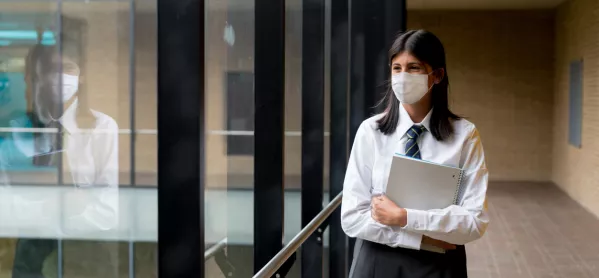Covid-19: Fall in schools with self-isolating pupils

The number of schools with one or more pupils self-isolating has fallen for the first time since the beginning of last month.
The data, published today by the Department for Education, also shows that the estimated number of pupils absent from school for Covid-related reasons has dropped - from 876,000 on 19 November to 798,000 to 26 November.
It follows two weeks of increases in the number of pupils off school.
Last week: School Covid cases soar to hit 73% of secondaries
SEND: Warning over 1 in 4 special school pupils ‘sat at home’
Covid: Fears Covid in schools will cancel teachers’ Christmas
Today’s DfE document states: “From Thursday 5 November, there was a steady increase in the number of schools reporting that they have had one or more pupils self-isolating, who had been asked to do so due to potential contact with a case of coronavirus inside the school, reaching 36 per cent on Thursday 19 November.
“On Thursday 26 November, 33 per cent of schools fell into this category, showing a decrease compared to last week. Note that the vast majority of these schools remain open to most pupils.”
This equates to 68 per cent of state secondaries, down from 73 per cent last week; and 26 per cent of state primaries, down from 29 per cent last week.
The DfE data also shows that the proportion of schools with 30 or more pupils self-isolating owing to possible contact with Covid was between 23 and 25 per cent on 26 November, down from between 25 and 27 per cent the previous week.
Kevin Courtney, joint-general secretary of the NEU teaching union, said: “Yet again school attendance figures are dreadful - more than one in five secondary pupils were absent and one in eight primary pupils.
“The lockdown has failed to bring down coronavirus cases among pupils and so school attendance is significantly lower than when the second lockdown began.
“The only way to improve school attendance is for the government to act to bring down coronavirus infection rates in schools.
“While the national figures are dreadful, we also know they are averages. There is very significant regional and local variation. The government are hiding this information from the public because it will show how much disruption coronavirus is causing particularly in the North of England and how unfair their plans are to run exams with only minor adjustments next summer.”
Geoff Barton, general secretary of the Association of School and College Leaders, said: “The number of schools that had to send home children to self-isolate fell slightly last week compared to the week before, but the level of disruption is still very significant.
“The health secretary said yesterday that the national lockdown had helped to bring coronavirus back under control.
“It will not feel like that in many schools that continue to operate under very difficult circumstances because of the impact of the pandemic.
“We are particularly concerned about the final week of term when any positive cases will result in many children and staff having to self-isolate over Christmas in line with Covid protocols.
“We are pressing the government to allow schools to move to partial or full remote learning during that week if they feel this would help address the situation.
“Parents, children, and school staff surely deserve this small degree of flexibility from the government at the end of an extremely stressful term.”
Paul Whiteman, general secretary of school leaders’ union NAHT, said: “Schools are still struggling to navigate the impacts of Covid on their cohorts. Both staff and pupil attendance figures are fluctuating massively, and the situation varies from region to region and between individual schools.
“School leaders and their teams are doing their very best to not just keep schools open but to attempt to catch up on learning and to help mitigate the impact of lockdown on children’s wellbeing.
“But they are still operating largely in the dark, with the government dragging its heels on crucial announcements. Schools are concerned that their plans for the last few weeks of term, and for the start of the new term in January, are at risk of falling apart due to the government’s messaging around Christmas.”
A Department for Education spokesperson said: “It is a national priority to keep education settings open full-time, which is supported by the chief medical officer who has highlighted the damage caused by not being in education to children’s learning, development and mental health.
“Schools, colleges and early years settings across the country have worked extremely hard to remain open, implementing safety measures and scaling up remote education provision for those children who are self-isolating, with approximately 99 per cent of schools open each week since the start of term.”
You need a Tes subscription to read this article
Subscribe now to read this article and get other subscriber-only content:
- Unlimited access to all Tes magazine content
- Exclusive subscriber-only stories
- Award-winning email newsletters
Already a subscriber? Log in
You need a subscription to read this article
Subscribe now to read this article and get other subscriber-only content, including:
- Unlimited access to all Tes magazine content
- Exclusive subscriber-only stories
- Award-winning email newsletters